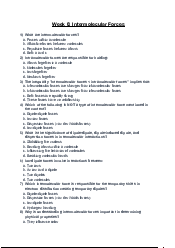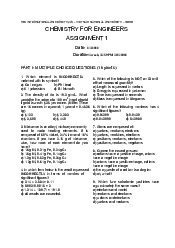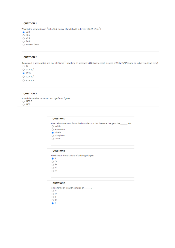

Preview text:
THE INTERNATIONAL UNIVERSITY (IU) – VIETNAM NATIONAL UNIVERSITY – HCMC CHEMISTRY FOR ENGINEERS ASSIGNMENT 2 Date : 10/1/2023
Duration : 1 week, 17/1/2023
Part I: MULTIPLE CHOICE QUESTIONS (5pts)
1. The octet rule states that:
a. Elements become stable by having 8 electrons
b. Elements become stable by having 8 valence electrons
c. Same number of protons and electrons d. Conserving electrons
2. Choose the species that is incorrectly matched with the electronic geometry about the central atom. a. NO - - 2 - trigonal planar b. ClO4 - tetrahedral c. SO 2- - 3 - pyramidal d. ClO3 - tetrahedral
3. In an actual SO2 molecule, the indicated angle would best be described as… A. Greater than 90° G. Greater than 120° M. Cannot be predicted B. Equal to 90° H. Equal to 120° C. Less than 90° I. Less than 120° O
D. Greater than 109½° J. Greater than 180° E. Equal to 109½° K. Equal to 180° F. Less than 109½° L. Less than 180° O S
4. Covalent compounds are formed by: a. Transfer of electrons b. Gaining electrons c. Losing electrons d. Sharing electrons
5. Why do elements form compounds? a. To form new compounds
b. To become stable like the noble gases c. To become unstable d. To give away electrons
Part II: CONSTRUCTED QUESTIONS (95pts)
1. Draw the three resonance structures of carbonate ion, CO 2- 3 . (6pts)
2. Draw the three resonance structures of nitrate ion, NO3-. ( pts) 6
3. Use electronegativities to determine whether the bonds in the following compounds are ionic
or covalent. Show your reasoning. (12pts)
Electronegativities: Ca, 1.3; O, 3.4; C, 2.6, Na, 0.9; Mg, 1.3; S, 2.6; I, 2.7; N, 3.0; Br, 3.0. a.CO2 d. MgI b.CaO e.SO2 c.NaBr f.NI3
4. Draw the Lewis structures of the following molecules; name the shape of the molecule (not the
electron arrangement); state whether the molecule is polar or non-polar by using dipole moment
and determine idealize bond angle of the molecule. Resonance structures may be ignored. (36pts). a. HCCH
e. SiH2Cl2 (Si is center atom) b. PF3 - c. IF f. SCN ( C is center atom) 5 g.AlCl3 d.Cl2CO (C is center atom) h. H2O
5. Show your understand about inte molecular r forces and intr molecular a forces? How many types
of intermolecular forces are there? Definition of each types? Give example with explanations (at
least 3 compounds for each type)? Arrange them from the weakness to strongest. (25pts)
6. Lee Jong-suk , a first year student who failed Chemistry for Engineering course, is now taking
a terrible nightmare with lecture 7: Intermolecular Forces. Students! By using knowledge you have
learnt please answer this question to help Lee come over lecture 7. The question is: How do
intermolecular forces affect the melting and boiling points of the compound? (10pts) Good luck!!!
NOTE FOR DRAWING LEWIS AND RESONANCE STRUCTURES:
_ Show each bonding pair of electrons as a line (—)
_ Show non-bonding valence electrons as dots (:).
_ Get 0pt for missing any electron in compound or mistake from drawing compound.




